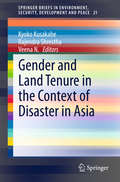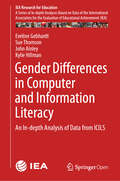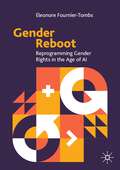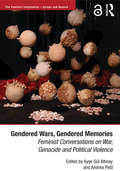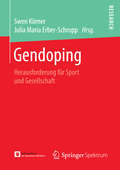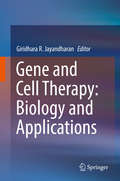- Table View
- List View
Gender and Early Television: Mapping Women’s Role in Emerging US and British Media, 1850-1950 (Library of Gender and Popular Culture)
by Sarah ArnoldBetween the nineteenth century and the mid-twentieth century television transformed from an idea to an institution. In Gender and Early Television, Sarah Arnold traces women's relationship to the new medium of television across this period in the UK and USA. She argues that women played a crucial role in its development both as producers and as audiences long before the 'golden age' of television in the 1950s.Beginning with the emergence of media entertainment in the mid-nineteenth century and culminating in the rise of the post-war television industries, Arnold claims that, all along the way, women had a stake in television. As keen consumers of media, women also helped promote television to the public by performing as 'television girls'. Women worked as directors, producers, technical crew and announcers. It seemed that television was open to women. However, as Arnold shows, the increasing professionalisation of television resulted in the segregation of roles. Production became the sphere of men and consumption the sphere of women. While this binary has largely informed women's role in television, through her analysis, Arnold argues that it has not always been the case.
Gender and Early Television: Mapping Women’s Role in Emerging US and British Media, 1850-1950 (Library of Gender and Popular Culture)
by Sarah ArnoldBetween the nineteenth century and the mid-twentieth century television transformed from an idea to an institution. In Gender and Early Television, Sarah Arnold traces women's relationship to the new medium of television across this period in the UK and USA. She argues that women played a crucial role in its development both as producers and as audiences long before the 'golden age' of television in the 1950s.Beginning with the emergence of media entertainment in the mid-nineteenth century and culminating in the rise of the post-war television industries, Arnold claims that, all along the way, women had a stake in television. As keen consumers of media, women also helped promote television to the public by performing as 'television girls'. Women worked as directors, producers, technical crew and announcers. It seemed that television was open to women. However, as Arnold shows, the increasing professionalisation of television resulted in the segregation of roles. Production became the sphere of men and consumption the sphere of women. While this binary has largely informed women's role in television, through her analysis, Arnold argues that it has not always been the case.
Gender and Land Tenure in the Context of Disaster in Asia (SpringerBriefs in Environment, Security, Development and Peace #21)
by Kyoko Kusakabe Rajendra Shrestha Veena N.This book explores an interdisciplinary field at the intersection of gender and development studies, disaster and land tenure policy. It is well known that women generally have weaker claims to land. But how does that translate to increased vulnerability during disaster? Using case studies from Asia, this book argues that land tenure is a key factor in mitigating the impact of disasters on women. The scale and frequency of disasters have been increasing in recent decades due to human impact on the landscape and climate. Unsustainable farming and land management systems have increased environmental risks and social vulnerabilities. However, around the world the costs of disasters are disproportionately borne by women, due largely to their reduced mobility and lack of control over assets. In post-disaster settings, women’s vulnerabilities increase due to gendered rescue and rehabilitation practices. As such, a gendered approach to land rights is critical to disaster preparedness and recovery.
Gender and Rural Globalization: International Perspectives on Gender and Rural Development
by Monika Agarwal Margaret Alston Berit Brandth Angela Calvo Megan Canning Anne Cassidy Francesca Alice Centrone Majda Cernic Istenic Chrysanthi Charatsari Jessica Duncan Elisabeth Garner Donatella Greco Wendy Harcourt Marit S. Haugen Susie Jacobs Lori Ann McVay Ilona Matysiak Peter Mollinga Janet Momsen Angela Mosso Caoimhe Ni Dhonaill Nargiza Nizamedinkhodjayeva Mark Riley Carolyn Sachs Heather Sangster Sally Shortall Susanne Stenbacka Margreet van der Burg Chiara ZanettiThis book explores how rural gender relations are changing in a globalising world that fundamentally impacts on the structure of agricultural life in rural areas and urban-rural relations. It analyses the development of rural gender relations in specific places around the world and looks into the effects of the increasing connectivity and mobility of people across places. The themes covered are: gender and mobility, gender and agriculture, Gender and rural politics, rurality and Gender identity and women and international development. Each theme has an overview of the state of the art in that specific thematic area and integrates the case-studies that follow.
Gender Aspects of Climate Change and Sustainable Development: A Global Overview (Science for Sustainable Societies)
by Isabel B. Franco Syeda Umama Mehreen Anuska JoshiThis book addresses how sustainability discourse and advocacy can translate to impactful policies especially when bridging the divide between sustainability, climate change and gender. The book explores various areas, such as conservation, climate action, sustainable fashion, and corporate sustainability, and defines the existing sustainability gaps in the selected cases (country/sector/region). It highlights the value of sustainability science and climate change on innovative approaches to research, education, capacity-building, and practice to transform rhetoric into impact sustainability while encompassing cases from various industries, sectors, and geographical contexts. While emphasizing SDG 5, the book chapters also show the transboundary implications of gender equality and inclusivity to other sustainable development and climate change goals and targets. The contributions are exemplary in highlighting the relation of gender inclusivity in strengthening efforts to protect andsafeguard the world’s cultural and natural heritage and making cities and human settlements inclusive and safe (Goal 11), protecting, restoring, and promoting sustainable management of terrestrial ecosystems and reverse land degradation (Goal 15), ensuring access to affordable, reliable, sustainable and modern energy for all (Goal 7), promoting sustainable and inclusive economic growth with productive and decent employment for all (Goal 8), promoting inclusive and sustainable industrialization (Goal 9), adopt policies to reduce inequalities (Goal 10), ensure sustainable consumption and production pattern (Goal 12), addressing climate change impacts and building resilience (Goal 13), and ensuring availability and sustainable management of water and sanitation for all (Goal 6).
Gender Differences in Computer and Information Literacy: An In-depth Analysis of Data from ICILS (IEA Research for Education #8)
by Eveline Gebhardt Sue Thomson John Ainley Kylie HillmanThis open access book presents a systematic investigation into internationally comparable data gathered in ICILS 2013. It identifies differences in female and male students’ use of, perceptions about, and proficiency in using computer technologies. Teachers’ use of computers, and their perceptions regarding the benefits of computer use in education, are also analyzed by gender. When computer technology was first introduced in schools, there was a prevailing belief that information and communication technologies were ‘boys’ toys’; boys were assumed to have more positive attitudes toward using computer technologies. As computer technologies have become more established throughout societies, gender gaps in students’ computer and information literacy appear to be closing, although studies into gender differences remain sparse. The IEA’s International Computer and Information Literacy Study (ICILS) is designed to discover how well students are prepared for study, work, and life in the digital age. Despite popular beliefs, a critical finding of ICILS 2013 was that internationally girls tended to score more highly than boys, so why are girls still not entering technology-based careers to the same extent as boys? Readers will learn how male and female students differ in their computer literacy (both general and specialized) and use of computer technology, and how the perceptions held about those technologies vary by gender.
Gender in Agriculture: Closing the Knowledge Gap
by Agnes R. Quisumbing Ruth Meinzen-Dick Terri L. Raney André Croppenstedt Julia A. Behrman Amber PetermanThe Food and Agriculture Organization of the United Nations (FAO) produced a 2011 report on women in agriculture with a clear and urgent message: agriculture underperforms because half of all farmers—women—lack equal access to the resources and opportunities they need to be more productive. This book builds on the report’s conclusions by providing, for a non-specialist audience, a compendium of what we know now about gender gaps in agriculture.
Gender in Music Production (Perspectives on Music Production)
by Russ Hepworth-Sawyer Jay Hodgson Liesl King Mark MarringtonThe field of music production has for many years been regarded as male-dominated. Despite growing acknowledgement of this fact, and some evidence of diversification, it is clear that gender representation on the whole remains quite unbalanced. Gender in Music Production brings together industry leaders, practitioners, and academics to present and analyze the situation of gender within the wider context of music production as well as to propose potential directions for the future of the field. This much-anticipated volume explores a wide range of topics, covering historical and contextual perspectives on women in the industry, interviews, case studies, individual position pieces, as well as informed analysis of current challenges and opportunities for change. Ground-breaking in its synthesis of perspectives, Gender in Music Production offers a broadly considered and thought-provoking resource for professionals, students, and researchers working in the field of music production today.
Gender in Music Production (Perspectives on Music Production)
by Jay Hodgson Russ Hepworth-Sawyer Mark Marrington Liesl KingThe field of music production has for many years been regarded as male-dominated. Despite growing acknowledgement of this fact, and some evidence of diversification, it is clear that gender representation on the whole remains quite unbalanced. Gender in Music Production brings together industry leaders, practitioners, and academics to present and analyze the situation of gender within the wider context of music production as well as to propose potential directions for the future of the field. This much-anticipated volume explores a wide range of topics, covering historical and contextual perspectives on women in the industry, interviews, case studies, individual position pieces, as well as informed analysis of current challenges and opportunities for change. Ground-breaking in its synthesis of perspectives, Gender in Music Production offers a broadly considered and thought-provoking resource for professionals, students, and researchers working in the field of music production today.
Gender Integration in NATO Military Forces: Cross-national Analysis (Gender in a Global/Local World)
by Lana ObradovicNumerous states have passed gender integration legislation permanently admitting women into their military forces. As a result, states have dramatically increased women’s numbers, and improved gender equality by removing a number of restrictions. Yet despite changes and initiatives on both domestic and international levels to integrate gender perspectives into the military, not all states have improved to the same extent. Some have successfully promoted gender integration in the ranks by erasing all forms of discrimination, but others continue to impede it by setting limitations on equal access to careers, combat, and ranks. Why do states abandon their policies of exclusion and promote gender integration in a way that women’s military participation becomes an integral part of military force? By examining twenty-four NATO member states, this book argues that civilian policymakers and military leadership no longer surrender to parochial gendered division of the roles, but rather support integration to meet the recruitment numbers due to military modernization, professionalization and technological advancements. Moreover, it proposes that increased pressure by the United Nations to integrate gender into security and NATO seeking standardization and consistency on the international level, and women’s movements on the domestic level, are contributing to greater gender integration in the military.
Gender Integration in NATO Military Forces: Cross-national Analysis (Gender in a Global/Local World)
by Lana ObradovicNumerous states have passed gender integration legislation permanently admitting women into their military forces. As a result, states have dramatically increased women’s numbers, and improved gender equality by removing a number of restrictions. Yet despite changes and initiatives on both domestic and international levels to integrate gender perspectives into the military, not all states have improved to the same extent. Some have successfully promoted gender integration in the ranks by erasing all forms of discrimination, but others continue to impede it by setting limitations on equal access to careers, combat, and ranks. Why do states abandon their policies of exclusion and promote gender integration in a way that women’s military participation becomes an integral part of military force? By examining twenty-four NATO member states, this book argues that civilian policymakers and military leadership no longer surrender to parochial gendered division of the roles, but rather support integration to meet the recruitment numbers due to military modernization, professionalization and technological advancements. Moreover, it proposes that increased pressure by the United Nations to integrate gender into security and NATO seeking standardization and consistency on the international level, and women’s movements on the domestic level, are contributing to greater gender integration in the military.
Gender Issues In Farming Systems Research And Extension
by Susan V. PoatsThis book is the product of an international conference hosted by the Women in Agricultural Development (WIAD) Program at the University of Florida in 1986. The purpose of WIAD program is to promote an understanding of gender and its relevance for agricultural development processes.
Gender Issues In Farming Systems Research And Extension
by Susan V. Poats Marianne Schmink Anita SpringThis book is the product of an international conference hosted by the Women in Agricultural Development (WIAD) Program at the University of Florida in 1986. The purpose of WIAD program is to promote an understanding of gender and its relevance for agricultural development processes.
Gender, Power and Politics in Agriculture: Revisiting Theory and Practice
by Jemimah Njuki Hale Ann Tufan Vivian Polar Hugo Campos Monifa Morgan-BellThis is a open access book. In the agriculture sector, the language of gender integration often ignores the politics and the power dynamics that are central to critical, and feminist, analysis of gender relations. This volume explores largely neglected topics such as power dynamics, masculinities, gendered social norms, feminist research practice, intersectionality, critical analysis of tools and more, that are fundamental to shifting the entrenched power dynamics and politics of gender research in agriculture. The purpose of this book is to reduce the gap existing between theory, methods, and practice of gender relations in agriculture and agricultural research. Through an in-depth analysis of current processes in agriculture and drawing on existing experiences in other sectors, it seeks to create pathways for learning, catalyzing change and positive impact on gender equity and social inclusion. This volume seeks to bring forth a change in how gender relations in agriculture are researched, practiced and taught.
Gender Reboot: Reprogramming Gender Rights in the Age of AI
by Eleonore Fournier-TombsThis book explores gender norms and women’s rights in the age of AI. The author examines how gender dynamics have evolved in the spheres of work, self-image and safety, and education, and how these might be reflected in current challenges in AI development. The book also explores opportunities in AI to address issues facing women, and how we might harness current technological developments for gender equality. Taking a narrative tone, the book is interwoven with stories and a reflection on the raising young children during the COVID-19 pandemic. It includes both expert and personal interviews to create a nuanced and multidimensional perspective on the state of women’s rights and what might be done to move forward.
Gendered Wars, Gendered Memories: Feminist Conversations on War, Genocide and Political Violence (The Feminist Imagination - Europe and Beyond)
by Ay 351 e Gül Altı Nay Andrea Pet 337The Introduction of this book is freely available as a downloadable Open Access PDF under a Creative Commons Attribution-Non Commercial-No Derivatives 4.0 license available at http://www.taylorfrancis.com/books/e/9781315584225 The twentieth century has been a century of wars, genocides and violent political conflict; a century of militarization and massive destruction. It has simultaneously been a century of feminist creativity and struggle worldwide, witnessing fundamental changes in the conceptions and everyday practices of gender and sexuality. What are some of the connections between these two seemingly disparate characteristics of the past century? And how do collective memories figure into these connections? Exploring the ways in which wars and their memories are gendered, this book contributes to the feminist search for new words and new methods in understanding the intricacies of war and memory. From the Italian and Spanish Civil Wars to military regimes in Turkey and Greece, from the Armenian genocide and the Holocaust to the wars in Abhazia, East Asia, Iraq, Afghanistan, former Yugoslavia, Israel and Palestine, the chapters in this book address a rare selection of contexts and geographies from a wide range of disciplinary perspectives. In recent years, feminist scholarship has fundamentally changed the ways in which pasts, particularly violent pasts, have been conceptualized and narrated. Discussing the participation of women in war, sexual violence in times of conflict, the use of visual and dramatic representations in memory research, and the creative challenges to research and writing posed by feminist scholarship, Gendered Wars, Gendered Memories will appeal to scholars working at the intersection of military/war, memory, and gender studies, seeking to chart this emerging territory with ’feminist curiosity’.
Gendered Wars, Gendered Memories: Feminist Conversations on War, Genocide and Political Violence (The Feminist Imagination - Europe and Beyond)
by Ayşe Gül AltinayThe Introduction of this book is freely available as a downloadable Open Access PDF under a Creative Commons Attribution-Non Commercial-No Derivatives 4.0 license available at http://www.taylorfrancis.com/books/e/9781315584225 The twentieth century has been a century of wars, genocides and violent political conflict; a century of militarization and massive destruction. It has simultaneously been a century of feminist creativity and struggle worldwide, witnessing fundamental changes in the conceptions and everyday practices of gender and sexuality. What are some of the connections between these two seemingly disparate characteristics of the past century? And how do collective memories figure into these connections? Exploring the ways in which wars and their memories are gendered, this book contributes to the feminist search for new words and new methods in understanding the intricacies of war and memory. From the Italian and Spanish Civil Wars to military regimes in Turkey and Greece, from the Armenian genocide and the Holocaust to the wars in Abhazia, East Asia, Iraq, Afghanistan, former Yugoslavia, Israel and Palestine, the chapters in this book address a rare selection of contexts and geographies from a wide range of disciplinary perspectives. In recent years, feminist scholarship has fundamentally changed the ways in which pasts, particularly violent pasts, have been conceptualized and narrated. Discussing the participation of women in war, sexual violence in times of conflict, the use of visual and dramatic representations in memory research, and the creative challenges to research and writing posed by feminist scholarship, Gendered Wars, Gendered Memories will appeal to scholars working at the intersection of military/war, memory, and gender studies, seeking to chart this emerging territory with ’feminist curiosity’.
Gendoping: Herausforderung für Sport und Gesellschaft
Die Beiträge des Sammelbandes beleuchten die unterschiedlichen Positionen zum Enhancement im Sport mit dem Schwerpunkt Gendoping. Sie zeigen Perspektiven aus Medizin, Ethik, Recht, Soziologie, Philosophie und Sportwissenschaft auf, welche insbesondere die Debatte prägen, sie diskutieren konträre ethische Positionen (konservativ vs. liberal), erarbeiten Handlungsempfehlungen (Verbot vs. Freigabe) und thematisieren die Probleme der Prävention und der Nachweisbarkeit. Die Publikation trägt zur Entschlüsselung der Diskrepanzen um Gendoping bei, indem sie die unterschiedlichen zugrundeliegenden theoretischen, empirischen, soziokulturellen, rechtlichen, ethischen sowie anthropologischen Standpunkte mit- und gegeneinander ins Gespräch bringt.
Gene and Cell Therapy: Biology and Applications
by Giridhara R. JayandharanRecent advances in stem cell biology, nanotechnology and gene therapy have opened new avenues for therapeutics. The availability of molecular therapeutics that rely on the delivery of DNA, RNA or proteins, harnessing enhanced delivery with nanoparticles, and the regenerative potential of stem cells (adult, embryonic or induced pluripotent stem cells) has had a tremendous impact on translational medicine. The chapters in this book cover a range of strategies for molecular and cellular therapies for human disease, their advantages, and central challenges to their widespread application. Potential solutions to these issues are also discussed in detail. Further, the book addresses numerous advances in the field of molecular therapeutics that will be of interest to the general scientific community. Lastly, the book provides specific examples of disease conditions for which these strategies have been transferred to the clinic. As such, it will be extremely useful for all students, researchers and clinicians working in the field of translational medicine and molecular therapeutics.
Gene Banks and the World's Food
by Donald L. Plucknett Nigel J.H. SmithGene Banks and the World's Food contributes to the crucial debate on how best to preserve some of society's most valuable raw material. The authors also provide an up-to-date report on the status and locations of gene banks, which includes the latest available information on germplasm holdings by crop. They (hen discuss how these holdings are being used to develop better crop varieties for the benefit of people around the world.Originally published in 1986.The Princeton Legacy Library uses the latest print-on-demand technology to again make available previously out-of-print books from the distinguished backlist of Princeton University Press. These editions preserve the original texts of these important books while presenting them in durable paperback and hardcover editions. The goal of the Princeton Legacy Library is to vastly increase access to the rich scholarly heritage found in the thousands of books published by Princeton University Press since its founding in 1905.
Gene Drives at Tipping Points: Precautionary Technology Assessment and Governance of New Approaches to Genetically Modify Animal and Plant Populations
by Arnim Von Gleich Winfried SchröderThis open access book reports on a pilot project aiming at collecting information on the socio-ecological risks that could arise in the event of an uncontrolled spread of genetically engineered organisms into the environment. The researchers will, for instance, be taking a closer look at genetically engineered oilseed rape, genetically engineered olive flies as well as plants and animals with so-called gene drives. The book mainly adresses researchers.
Gene Editing in Plants: CRISPR-Cas and Its Applications
by Ashwani Kumar Sudipti Arora Shinjiro Ogita Yuan-Yeu Yau Krishnendu MukherjeeThis book is a collection of information about applying CRISPR-Cas systems for genome editing in plants. The main focus of this book is to address the recent advances and future prospects of CRISPR-Cas technology in crops.Genome editing technology is important because it can be used to improve plant traits. The earlier genome-engineering tools, zinc finger nucleases (ZFNs), and TAL effector nucleases (TALENs) are complicated to design and not flexible. The novel genome editor, CRISPR-Cas systems, has advantages over ZFNs and TALENs. The advantages are simple and easy to design precision in targeting and efficiency. Due to its precision and simplicity, the CRISPR-Cas technology has rapidly become the most popular genome-editing platform in life-science fields. CRISPR-Cas technology has been used widely for human gene therapy to treat diseases and for plant breeding programs for crop improvement.This book is of interest and useful to genome-editing professionals, plant breeders, horticulturists, field-level extension workers, nurserymen, planters, ecologists, and valuable source of reference to the relevant researchers.
Gene Editing, Law, and the Environment: Life Beyond the Human (Law, Science and Society)
by Irus BravermanTechnologies like CRISPR and gene drives are ushering in a new era of genetic engineering, wherein the technical means to modify DNA are cheaper, faster, more accurate, more widely accessible, and with more far-reaching effects than ever before. These cutting-edge technologies raise legal, ethical, cultural, and ecological questions that are so broad and consequential for both human and other-than-human life that they can be difficult to grasp. What is clear, however, is that the power to directly alter not just a singular form of life but also the genetics of entire species and thus the composition of ecosystems is currently both inadequately regulated and undertheorized. In Gene Editing, Law, and the Environment, distinguished scholars from law, the life sciences, philosophy, environmental studies, science and technology studies, animal health, and religious studies examine what is at stake with these new biotechnologies for life and law, both human and beyond.
Gene Editing, Law, and the Environment: Life Beyond the Human (Law, Science and Society)
by Irus BravermanTechnologies like CRISPR and gene drives are ushering in a new era of genetic engineering, wherein the technical means to modify DNA are cheaper, faster, more accurate, more widely accessible, and with more far-reaching effects than ever before. These cutting-edge technologies raise legal, ethical, cultural, and ecological questions that are so broad and consequential for both human and other-than-human life that they can be difficult to grasp. What is clear, however, is that the power to directly alter not just a singular form of life but also the genetics of entire species and thus the composition of ecosystems is currently both inadequately regulated and undertheorized. In Gene Editing, Law, and the Environment, distinguished scholars from law, the life sciences, philosophy, environmental studies, science and technology studies, animal health, and religious studies examine what is at stake with these new biotechnologies for life and law, both human and beyond.
Gene Expression Programming: Mathematical Modeling by an Artificial Intelligence (Studies in Computational Intelligence #21)
by Candida FerreiraThis book describes the basic ideas of gene expression programming (GEP) and numerous modifications to this powerful new algorithm. It provides all the implementation details of GEP so that anyone with elementary programming skills will be able to implement it themselves. The book includes a self-contained introduction to this new exciting field of computational intelligence. This second edition has been revised and extended with five new chapters.

